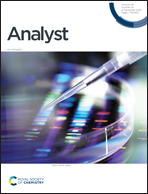Organic acid shift reagents for the discrimination of carbohydrate isobars by ion mobility-mass spectrometry†
Abstract
Carbohydrates are the most abundant class of biomolecules on Earth with a diverse array of biological functions. It is hypothesized that they likely had an important role in the development of life on the primoridal Earth as well. Since sugars have a variety of possible isobaric structures, it is necessary to characterize oligosaccharides beyond their molecular weight. Ion mobility-mass spectrometry (IM-MS) is a promising characterization technique for this purpose, as it is based on differences in charge and collision cross section (CCS). This study reports on the use of new noncovalent ligands as shift reagents to aid in the IM separations of disaccharides. A variety of organic acids were tested as shift reagents with traveling wave IM with the most promising ones being further investigated by drift tube IM. Drift tube IM provided higher resolution separations for the large majority of disaccharide complexes studied. Combining CCS results of the two most promising shift reagents allowed for the complete differentiation of all eight disaccharide standards examined in this study.



 Please wait while we load your content...
Please wait while we load your content...